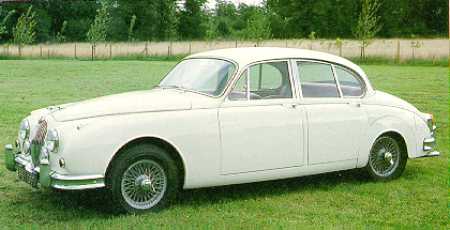The Jaguar MK II 1959-1967 |
| Years |
1959-1967 |
| See also |
Jaguar 2.4 and 3.4 MK I
Jaguar 240/340
Jaguar "S" type
Timeline for the Jaguar models (coming soon) |
| Notes |
The MK II range was an evolution of the earlier Jaguar 2.4 and 3.4 models. These cars were renamed in
retrospect to the MK I 2.4 and 3.4. All engine sizes were fitted with the "B"
type cylinder head. The Mk 1 models were in hindsight, somewhat overengineered (because of
being the first Jaguar monococque design), and the window frames had been made much
thicker than on other Jaguar models built on separate chassis. The Mk II featured a much
larger glass area, with separate window frames being substituted for the Mk 1's heavy
frames integrated into the door. The front and rear windshiekd were also larger. The
interior became much brighter because of the increased glass area, and the dash was
redesigned to place the speedometer and tachometer in front of the driver, with the
ancilliary instruments and controls placed in the center. This general arrangement was to
become a Jaguar "trademark" for the next 12 years, and was only changed with the
introduction of the Series II XJ6 in 1973. The Mk II became an instant
success, and both then and now totally overshadowed the original 2.4 and 3.4 designs. The
Mk II featured the same engine sizes, plus the addition of the 3.8 from the XK150. However
the Mk II was never fitted (from the factory) with the latters 'S' specification engine
with triple carburettors.
The Mk II was also significant as the car which spawned a host of variants during the
1960's from the S-Type of 1963, through the 420 of 1966. Each went upmarket, filling perceived gaps
between the compact Jaguars and the MKX (later
renamed as the 420G). |
| Description |
4 door sedan (saloon) |
| Colors |
See the compact sedan colors
page |
|

3.8 model. Note the optional wire wheels, and rear wheel spats |
| Engines |
| Model |
Engine |
Bore/Stroke |
Power |
| 2.4 |
2483cc 6 cyl twin overhead camshaft |
83 x 76.5 mm |
120 bhp @ 5750 rpm |
| 3.4 |
3442cc 6 cyl twin overhead camshaft |
83 x 106 mm |
210 bhp @ 5500 rpm |
| 3.8 |
3781cc 6 cyl twin overhead camshaft |
87 x 106 mm |
220 bhp @ 5500 rpm |
|
| Carburetors |
| 2.4 |
Twin Solex downdraught |
| 3.4 |
Twin SU HD6 |
| 3.8 |
Twin SU HD6 |
|
|
All engines are versions of the Jaguar XK type
DOHC inline 6 |
| Brakes |
4 wheel discs |
Production
(Various sources differ, slightly) |
| 2.4 right hand drive |
21768 |
|
| 2.4 left hand drive |
3405 |
Total 2.4 25173 |
| 3.4 right hand drive |
22092 |
|
| 3.4 left hand drive |
6571 |
Toral 3.4 28663 |
| 3.8 right hand drive |
15383 |
|
| 3.8 left hand drive |
14757 |
Total 3.8 30140 |
All models - 83976 |
|
| Weight |
| 2.4 |
3192 pounds |
| 3.4 |
3304 pounds |
| 3.8 |
3360 pounds |
|
| Length |
15 feet |
| Height |
4 feet 9 1/2 inches |
| Width |
5 feet 6 1/2 inches |
| Top speed |
96/120/125mph (Manual cars with
overdrive) |
| Wheelbase |
107.375 inches |
| Transmission |
4-speed manual. Overdrive optional. Also available, Borg
Warner 3 speed automatic. Until September 1965 the manual gearbox was the old design Moss
box, and was replaced then with a new all synchomesh box. |
| Suspension |
| Front |
Independent. Coil springs, wishbones and anti-roll bar |
| Rear |
Live axle, radius arms, Panhard rod, half elliptic leaf springs. |
|
| Chassis Numbers |
Additional codes with number
DN suffix means car is fitted with overdrive
BW suffix means car is fitted with automatic gearbox
P prefix means car is fitted with power steering |
| 2.4 |
100001-121769 (RHD models)
125001-128405 (LHD models). |
| 3.4 |
150001-172095 (RHD models)
175001-181571 (LHD models) |
| 3.8 |
200001-235383 (RHD models)
210001-224758 (LHD models) |
|
| Engine Numbers |
See the compact sedans engine
number page |
| Standard Equipment |
Leather seats, fog/spot lights.Hub caps (standard wheels)
Note: Leather seats were fitted as standard until 1967, the last year of manufacture, when
Ambla became standard, with leather still optional to keep base cost down. The fog/spot
lights also became optional at this time. |
| Options |
Automatic transmission, overdrive, wire wheels (in body color,
chrome or stove enamel), wheel trims for steel wheels (available either as trim rings for
use with standard hubcap, or a complete wheeltrim ring which replaced the hubcap),
Laminated windshield, various radios, heated rear window, rear childproof locks,
seatbelts, steel sliding sunroof (very rarely fitted), wood rim steering wheel, reclining
front seats. Power steering was optional on 3.4 and 3.8 models from september 1960 (1961
model year). In addition special paint finishes were available to special order. |